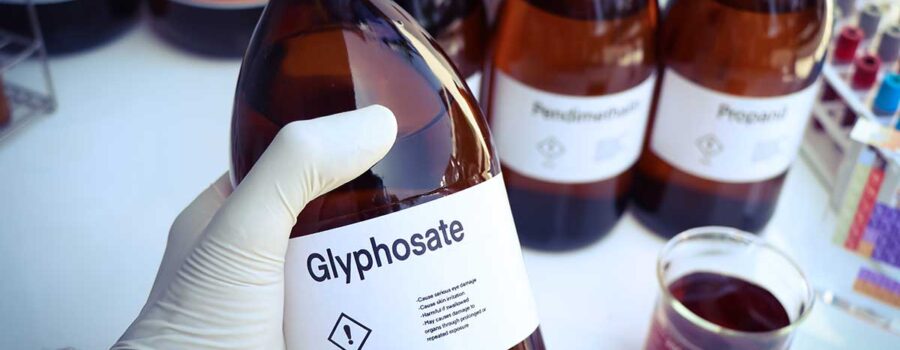In recent years, there has been increasing concern over Is Glyphosate Safe?, a widely used herbicide, in our environment. Initially celebrated as a breakthrough in agricultural efficiency, glyphosate’s ubiquitous application has resulted in alarming chemical levels permeating our water, air, and soil.
The impact of glyphosate on human health, particularly through its infiltration into our food supply, is a growing concern that cannot be ignored. Here, I want to alarm you with the levels of glyphosate found in various environmental mediums, explore its effects on the nutrients in our food, and discuss the intertwined relationships between Monsanto, big pharmaceutical companies, and big agriculture.
Glyphosate: A Brief Overview
Glyphosate is the active ingredient in Roundup, a popular herbicide initially introduced by Monsanto in the 1970s. It works by inhibiting a specific enzyme pathway necessary for plant growth, effectively killing unwanted weeds while leaving genetically modified crops unharmed.[1] Over the years, the use of glyphosate has skyrocketed, with millions of tons being sprayed annually across the globe.
Glyphosate in Water
One of the most concerning aspects of glyphosate contamination is its presence in water sources. Studies have detected glyphosate residues in rivers, lakes, and drinking water. This contamination occurs primarily through agricultural runoff, where rainwater washes glyphosate from treated fields into nearby water bodies.[2] Once in the water system, glyphosate can persist for extended periods, posing a threat to aquatic life and human health.
The presence of glyphosate in drinking water is particularly alarming. Chronic exposure to low levels of glyphosate through drinking water has been linked to a variety of health issues, including endocrine disruption, reproductive problems, and cancer. The World Health Organization’s International Agency for Research on Cancer (IARC) classified glyphosate as “probably carcinogenic to humans” in 2015, adding to the growing concern over its widespread use.[3,4]
Glyphosate in Air
Glyphosate can also become airborne through a process known as spray drift. During application, especially in windy conditions, glyphosate particles can be carried away from the target area, settling on neighboring fields, homes, and distant communities. Research has shown that glyphosate can be detected in the air far from the application site, raising concerns about its inhalation by humans and animals.
Airborne glyphosate poses a particular risk to agricultural workers and residents in farming communities, who are often exposed to higher chemical concentrations. Long-term inhalation of glyphosate has been associated with respiratory issues, skin problems, and other health complications.[5]
Glyphosate in Rainwater
Another alarming aspect of glyphosate contamination is its presence in rainwater. Studies have detected glyphosate residues in rainfall, indicating that the chemical is being transported through the atmosphere and deposited far from its original application sites. This phenomenon occurs through a process called atmospheric deposition, where glyphosate particles or vapors become airborne and are then carried by wind and clouds. As a result, even regions with minimal direct glyphosate usage can experience contamination.[6]
The presence of glyphosate in rainwater poses a significant threat to both the environment and human health, as it can infiltrate water supplies, disrupt ecosystems, and continue the cycle of contamination by depositing onto soils and crops. This widespread dispersion highlights the pervasive nature of glyphosate and underscores the urgent need for comprehensive measures to address its environmental and health impacts.
Glyphosate in Soil and Its Impact on Food
Glyphosate’s extensive use has led to significant soil accumulation, affecting our food’s nutrients. Glyphosate binds strongly to soil particles and can persist for months or even years. This persistence can disrupt soil ecosystems, harming beneficial microorganisms and reducing soil fertility.
One of the most insidious effects of glyphosate is its impact on the nutrient content of crops. Glyphosate can chelate essential minerals such as manganese, iron, and zinc, making them unavailable to plants. As a result, crops grown in glyphosate-contaminated soils may have lower levels of these crucial nutrients, which can lead to deficiencies in our diet. Moreover, glyphosate has been shown to interfere with the absorption of these nutrients in the human body, further exacerbating the problem.[7]
The Monsanto Connection: Big Agriculture and Big Pharma
Monsanto, now a subsidiary of Bayer, has long been at the center of the controversy surrounding glyphosate. The company’s development of glyphosate-resistant genetically modified organisms (GMOs) has significantly increased the herbicide’s use. These GMOs are engineered to withstand heavy glyphosate applications, allowing farmers to spray their fields liberally without harming their crops. This has resulted in an alarming rise in glyphosate residues in the environment and our food.
The ties between Monsanto, big pharmaceutical companies, and big agriculture are complex and concerning. Monsanto’s influence on agricultural practices has led to a near-monopoly on certain crops, while its relationship with pharmaceutical giants has raised questions about potential conflicts of interest. For instance, some argue that the same companies profiting from the sale of glyphosate also benefit from treating diseases potentially caused by this chemical. This symbiotic relationship raises ethical questions about the motivations behind the promotion and widespread use of glyphosate.[8]
The Slow Poisoning
The pervasive presence of glyphosate in our environment clearly indicates that this chemical is slowly poisoning us. Its infiltration into our water, air, and soil, coupled with its impact on the nutrient content of our food, poses a significant threat to public health. Chronic exposure to glyphosate, even at low levels, has been linked to a range of health issues, including cancer, reproductive problems, and developmental disorders.
As awareness of glyphosate’s dangers grows, we must take action to mitigate its impact. This includes advocating for stricter regulations on glyphosate use, supporting organic and sustainable farming practices, and demanding transparency from companies involved in its production and promotion. By doing so, we can work towards a healthier, toxin-free future for ourselves and future generations.
Conclusion
The widespread use of glyphosate has resulted in its alarming presence in our water, air, and soil, with far-reaching consequences for human health and the environment. The ties between Monsanto, big pharmaceutical companies, and big agriculture only add to the complexity and urgency of this issue. As we continue to uncover the true extent of glyphosate’s impact, it is clear that we must take decisive action to protect our health and the health of our planet. We can only mitigate the effects of this pervasive chemical and create a safer, healthier future for all through collective effort and informed choices.
References:
- Glyphosate Technical Fact Sheet. http://npic.orst.edu/factsheets/archive/glyphotech.html. Accessed 16 May 2024.
- Reynoso, Eduardo C., et al. “Determination of Glyphosate in Water from a Rural Locality in México and Its Implications for the Population Based on Water Consumption and Use Habits.” International Journal of Environmental Research and Public Health, vol. 17, no. 19, Oct. 2020, p. 7102. PubMed Central, https://doi.org/10.3390/ijerph17197102.
- de Araújo-Ramos, Anderson Tadeu, et al. “Controversies on Endocrine and Reproductive Effects of Glyphosate and Glyphosate-Based Herbicides: A Mini-Review.” Frontiers in Endocrinology, vol. 12, Mar. 2021, p. 627210. PubMed Central, https://doi.org/10.3389/fendo.2021.627210.
- Cressey, Daniel. “Widely Used Herbicide Linked to Cancer.” Nature, Mar. 2015. www.nature.com, https://doi.org/10.1038/nature.2015.17181.
- Gandhi, Kavita, et al. “Exposure Risk and Environmental Impacts of Glyphosate: Highlights on the Toxicity of Herbicide Co-Formulants.” Environmental Challenges, vol. 4, Aug. 2021, p. 100149. ScienceDirect, https://doi.org/10.1016/j.envc.2021.100149.
- Lupi, Leonardo, et al. “Glyphosate Runoff and Its Occurrence in Rainwater and Subsurface Soil in the Nearby Area of Agricultural Fields in Argentina.” Chemosphere, vol. 225, June 2019, pp. 906–14. ScienceDirect, https://doi.org/10.1016/j.chemosphere.2019.03.090.
- Duke, Stephen O., et al. “Glyphosate Effects on Plant Mineral Nutrition, Crop Rhizosphere Microbiota, and Plant Disease in Glyphosate-Resistant Crops.” Journal of Agricultural and Food Chemistry, vol. 60, no. 42, Oct. 2012, pp. 10375–97. PubMed Central, https://doi.org/10.1021/jf302436u.
- Raman, Ruchir. “The Impact of Genetically Modified (GM) Crops in Modern Agriculture: A Review.” GM Crops & Food, vol. 8, no. 4, Dec. 2017, pp. 195–208. PubMed Central, https://doi.org/10.1080/21645698.2017.1413522.








